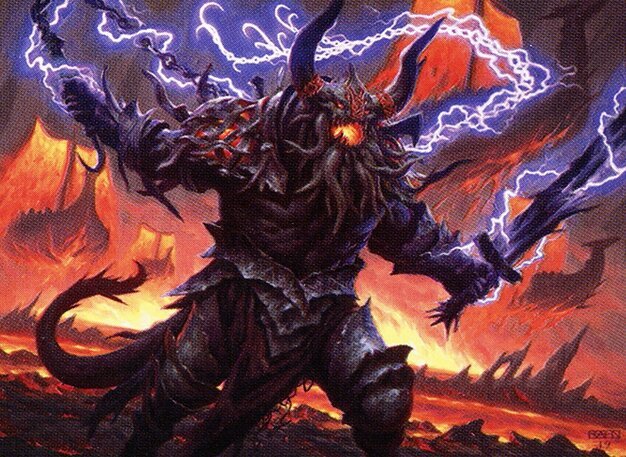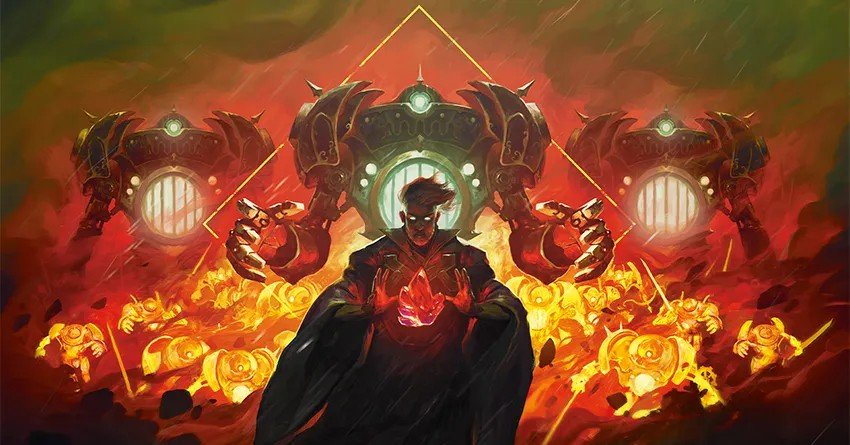Today we're going to explore a budget version of Mono Red Aggro Standard, with tips on how to act and a guide on which cards to purchase to upgrade the deck to a more competitive and complete version!
The Game Plan
When playing with Aggro decks, your goal is to dictate the pace of play and win in a few turns. Since the classic Burn, this is a theme where your starting hand and doing the math can be the difference between victory or defeat.
Interactions and Deck Building
This deck consists of 24 creatures, 4 enchantments, 2 sorceries, and 8 instants, with the highest cost being four mana among these cards.
Mono Red Budget List
We'll start by talking about the one mana cards:

Kumano Faces Kakkazan is one of the main cards in this deck, as this saga deals 1 damage, then puts a +1/+1 counter on the next creature that comes into play, and lastly transforms into a 2/2 with Haste. A card that for one mana gives us 2 effects that help us in the objective and another 2/2 creature.
Phoenix Chick is undoubtedly one of the best cards to play in the second turn after you've played Kumano Faces Kakkazan. As it has flying and haste, already dealing 2 damage to the opponent. And if your Phoenix Chick died if you attack with three or more creatures, you can pay two red mana and bring it from the graveyard to the battlefield, attacking with a +1/+1 counter.
Voldaren Epicure is a card that deals one extra point of damage and offers a token that helps us filter bad topdecks on later turns.
Play with Fire will normally be used to deal direct damage to your opponent, but it can be cast to finish off some opposing creature that could be trouble in the future.
On the two mana cards:

Lightning Strike, like Play with Fire, serves as an opponent's finisher or to eliminate a troublesome threata.
Reckless Impulse is perfect in the late game to grant some extra gas.
Voltaic Visionary, like Reckless Impulse, helps us speed up card draws to help with the goal of ending the game fast. The important thing is that if you play the exiled card with Voltaic Visionary, it turns into a 4/3!
Riveteers Requisitioner can enter with the blitz cost giving us a card draw (but being sacrificed later), or enter with the normal cost to continue attacking opponents more turns if we manage to eliminate possible blockers.
We have two three mana cards:

Daybreak Combatants is a 2/2 creature with haste that gives target creature +2/+0 upon entering the battlefield. We can give it to Phoenix Chick because of its evasion.
Flowstone Kavu is a creature with menace that, with its ability, can deal up to four of damage.

The only four-drop creature is Twinshot Sniper, which can be used with Channel to deal direct damage to the opponent or eliminate some creature, or even enter as a creature with reach dealing the same two damage.
As you can see, the deck is practically all back to dealing maximum damage to the opponent with low-cost cards.
Starting Hand
Your ideal starting hand is the one with Kumano Faces Kakkazan, Phoenix Chick and Play with Fire, along withVoltaic Visionary and Daybreak Combatants in addition to two mana.
However, we know that we will not always have these cards in hand to quickly aggress the opponent. So, when should we worry about Mulligan?
As it is a Budget deck without rares and mythics, we must consider the limitations we will have at the end of the game. It's important to have a one-drop, especially Kumano Faces Kakkazan, that on the second turn any card that enters the battlefield will have a +1/+1 counter to increase our pressure.
But as the deck is made to have a synergy of creatures and spells, what really worries us are the draws that can end up limiting us if there are too many lands. That's why we have some cards that help us to draw to get away from just having lands in our hand and losing control of the game as it extends.
Taking this into account, a hand with four mana leads us to think about a possible mulligan because if we are unlucky to draw 2 lands in a row, we end up losing the clock to finish the opponent. But if we have four lands and Reckless Impulse in the starting hand, maybe we can keep it.
And last, but not least: avoid heavy hands with too many three-drops.
Postures
Mono Red Aggro is the one who should dictate the game's pacing, being aggressive from the first turn to the finish. If at some point you change your attack posture to become defensive, you'll most likely lose the game.
Being aggressive doesn't always mean attacking with creatures and going all-in against your opponent's life. Wisely use Play with Fire, Lightning Strike and Twinshot Sniper to remove potential blockers or trade creatures that have more toughness than your creatures' power.
These trades should be made at key moments so that your pressure continues in the next few turns. Usually on the third or fourth turn, we have an idea of what our opponent is playing and how much damage we can deal, as well as how many turns it will take us to win the game by doing the damage calculations.
Facing Aggro decks, whoever has the best draw and the best starting hand will win, if the other deck is budget like yours. If they run rares and mythics, then you will have to count on the luck of good draws.
Facing Midranges and Control are smooth games, especially if you have explosive starting hands, it's hard for these decks to come back into the game.
Upgrading the Deck
Now that you're playing the budget version and farming Wildcards, what do you do? Which cards to buy?
I'll put here a list of competitive Mono Red Aggro for you to get the cards to improve your deck:
In the competitive version, we keep the deck strategy, but with many creatures with haste and/or increasing the power of your other creatures.
The priority list in order would be with Rare Wildcards:
Sokenzan, Crucible of Defiance
With Mythic Wildcards, the priority is:
When swapping cards, try to replace them in the following order:
Conclusion
Mono Red Aggro has always been a cheap option for competitive and entry formats within Arena.
So, that's it for today, I hope you enjoyed the article and especially understood the deck. Leave your feedback for improvements!












— Comments 0
, Reactions 1
Be the first to comment